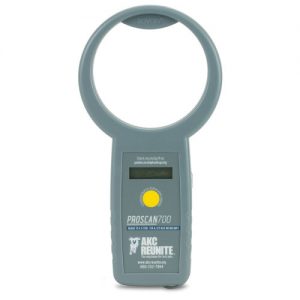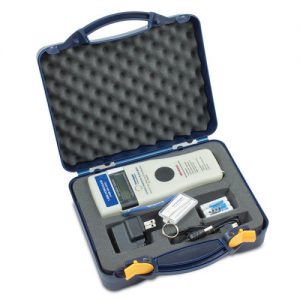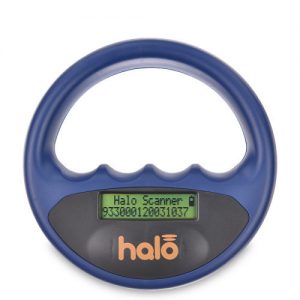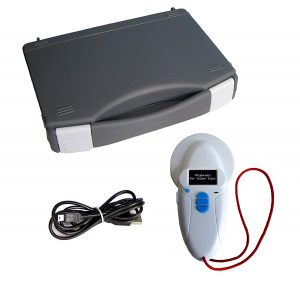The Top 5 Microchip Scanner for Dogs
Pressed for time? Skip straight to our review of the top 5 dog microchip scanners for dogs.
Every year in the U.S. alone, more than 10 million dogs go missing. That’s according to statistics from the American Humane Association, AHA. This is undoubtedly a very large figure and one that goes to show just how vulnerable dogs or pets, in general, are to getting lost or stolen.
However, losing your dog doesn’t mean you’re not a caring pet owner. Any dog can wander off at any given moment despite your best attempts to prevent it from doing so. And because you cannot keep your pet on permanent lock-down, the probability of them escaping is ever-present. Studies have also shown that out of every ten dogs, three of them are going to get lost at some point in their lives.
Given this fact, the best thing you can do is to increase the likelihood of finding your lost dog if that time unfortunately does come. In the past, most dog owners usually relied on identification tags and collars to make their dogs identifiable. But collars can get lost, stolen, or become illegible, leaving no other way to determine a dog’s owner.
Then the microchip was invented…
Today, microchips are a popular way to tag dogs for identification in the event that they get lost. They provide an additional and more reliable way to find a lost dog as microchips are a permanent solution that will outlive your dog by far.
Millions of pets around the world have already been microchipped and for good reason. Statistics show that microchip technology greatly increases the likelihood of owners being reunited with their lost pets. In some jurisdictions, local authorities even require that your pet is microchipped.
The benefits you get from microchipping your dog are many, as we will see. But first, here is a little more about the microchip.
What’s a Dog Microchip?
A microchip is essentially a tiny transponder that stores information and emits radio frequency (RF.) It comes in the form of a miniature capsule no bigger than a grain of rice. The capsule contains a microcircuitry capable of storing a unique code and this is the code that is used to identify the rightful owner of a lost pet.
The technology offers a reliable and safe way to find your lost dog as it is accurate and cannot be tampered with. Dog breeders use the chips to tag their dogs, and animal shelters rely on them to trace pet owners. The cost of having your dog injected with a microchip is also minuscule and to get your beloved pet microchipped, you will need to visit a vet.
How a Dog Microchip Works
The microchip contains a pet’s registration number as well as the contact details of the company that issued it. To access this information, a handheld device known as a microchip reader or scanner is used. The scanner is passed over the surface of the dog’s skin. Once it detects the microchip, the dog’s unique ID appears on an LCD screen.
The scanner works by sending a signal that activates the microchip, making it emit a radio frequency signal. It is through this RF signal that the microchip reader picks up the dog’s unique identification code as well as the contact details of the company that issued the chip. This company will have a database containing the contact details of the dog owner.
If the lost dog is yours, its ID code will match the name and address you provided and you will be confirmed as the owner, and plans made to reunite you with your dog. It’s a straightforward way for pet recovery and one that holds a higher likelihood of finding the real owners of lost dogs.
How is the Microchip Implanted?
The process to introduce a microchip into your pet’s body is a simple one. The procedure is similar to that of injecting a vaccine and only takes a few seconds. A needle is used to deliver the microchip into the tissue near the surface of the dog’s skin.
The process doesn’t require a dog to be under any anesthesia since it’s only as painful as a normal injection. The capsule is built to stay in place by sticking to the tissue surrounding it. It prevents it from moving away from where it was implanted which is usually between the shoulder blades.
How Safe is Microchipping Your Dog?
Implanting a microchip in your dog is safe; there are no dangers involved. Besides, it’s only injected near the skin’s surface and not in deep tissue. As a result, it doesn’t interfere with any organs to cause danger to your pet’s health. Effects common with needle jabs may appear, but they’re only that, and will rarely cause any serious complications.
The chip is also entirely passive, needing no battery to power it. It only ‘lights’ up when a scanner hovers near it. Also, the capsule that encases the circuitry is made from bioglass, a safe material that doesn’t react with the tissue in the pet’s skin.
The Advantages of A Dog Microchip
The benefits of microchipping your dog include the following:
- It is permanent. Once implanted, you’ll never need to worry about replacing it. It has a lifespan of about 25 years.
- A microchip is not prone to scratches, tearing, or any other damage that may compromise its reliability.
- It cannot be tampered with and is, therefore, secure and always accurate.
- Because it is electronic, it won’t fade or wear away so as to become unreadable.
- Pet registry companies for microchip identification may offer extra services in addition to helping find lost pets. The services might include transporting pets to their owners or offering the pets shelter until their owners can come to collect them.
- It cannot be taken out or stolen to hide the dog’s identity.
- In case of dog theft, it provides a sure way to settle a dispute regarding the rightful dog owner.
- It is very inexpensive, considering the reliability and durability it offers.
- Does not require a power source, allowing it to last a lifetime without requiring maintenance.
- Unlike dog collars and other ID tags that can fall off, your dog will never lose a microchip.
Enter Dog Microchip Readers
Microchips are not an island unto themselves. To produce the radio signal that communicates the ID code and pet registry contacts, they require the external power of a microchip scanner. These scanners are the ones that retrieve the unique number that identifies a dog and helps identify the owner. Without a scanner, the information contained in a microchip would remain inaccessible.
A microchip scanner for dogs is also useful in situations where you adopt a new dog. Before having them microchipped, you would need to use a scanner to find out if they already have been chipped. If they have, you won’t require another one, but will only need to update the pet registry with your details as the new owner.
Why Would You Need a Microchip Reader?
It is very possible that during some of your numerous walks with your dog, a stray dog comes along and begins to be friendly with your dog. Only to realize later that this stray dog is actually lost and its owner nowhere in sight. If the dog is hopefully microchipped, surely you can see how, if you owned a scanner, its owner can easily be located, an owner who will likely be profoundly grateful to you.
The reverse situation can of course happen where a total stranger finds your lost dog and uses their personal microchip reader to find you and return your dear pet to you. Surely you can hopefully see why owning your own personal microchip reader can come in very handy
A good microchip reader should read all kinds of identity microchips. These readers are known as universal scanners and are the standard types of chip readers today.
Top 5 Dog Microchip Readers to Consider Buying.
If you’re looking for a microchip scanner to buy either for personal use or commercial purposes, such as a vet’s clinic or animal shelter, here are 5 select models to consider buying. They come with top-notch features and excellent usability. Read through to choose the one that suits your needs and expectations.
1. ProScan 700 Microchip Scanner
The ProScan 700 is a microchip scanning tool that’s both easy and reliable to use. Pressing a button activates it to start searching and display a chip’s code immediately after it finds one. The sensitivity of this scanner is high, with the capability to detect from a  distance of up to 3 inches. It makes searching for a microchip implant on a dog easy.
distance of up to 3 inches. It makes searching for a microchip implant on a dog easy.
For a comfortable grip when holding it in your hand, it features an ergonomic design. You therefore won’t feel numb if you have to hold this scanner for long periods of time.
The device can also detect microchips of different frequencies, making it versatile enough to never miss finding a chip. It’s also capable of storing as many as 5,000 microchip numbers in its memory to enable faster identification.
To allow you to update its program any time you need to, it comes equipped with a USB port. It uses four AAA-size batteries to work and can run for up to three hours scanning continuously.
Key Features:
- Higher sensitivity
- USB connectivity
- Ergonomically designed handle
- Portable
2. HomeAgain Universal WorldScan Plus Scanner
This scanner is universal, meaning it can detect any chip brand emitting any range of RF frequency. Using it assures you of accurate detection. If it doesn’t find any chip, it means there isn’t one.
The sensitivity of the WorldScan Plus is enhanced by the bi-directional antenna it comes with. It makes scanning not only fast but also accurate. To enable quick detection, the scanner’s memory is capable of storing up to 3,000 identification numbers.
It has an ergonomic shape for the handle which means an easy grip that will not tire your hand. If you are involved in scanning pets for extended hours, the ergonomic design is a feature you will find useful to prevent hand or wrist fatigue.
The scanner features a USB connection. Should you need to transfer information from it to a computer, it will be as simple as connecting a cable. It also comes with Bluetooth functionality to enable a wireless connection between the scanner and any other device that features Bluetooth connectivity.
For enhanced durability, the WorldScan Plus is built to prevent the entry of moisture. You can use it in humid conditions without worry of damage. To further protect it from harsh environments, it comes with a storage case. Keeping it there when not in use will increase the life of the scanner and keep it in top working condition.
The scanner comes with six batteries that are rechargeable. You only need to plug it to the mains through a USB charger, and the battery is restored to ready the scanner for work.
Key Features:
- Universal reading
- Ergonomic handle
- Moisture resistant construction
- USB and Bluetooth connectivity
3. Halo Pet Microchip Scanner
This scanner is highly portable which makes it suitable for personal or field use. With a compact design, it fits into a small space such as your pocket. It’s also lightweight and carrying it around is not much of a hassle. Made from durable plastic, you can be sure that  it will serve you for a long time.
it will serve you for a long time.
The device reads various microchips of both ISO frequency standards and non-ISO frequencies. Making out the numbers displayed by the scanner is easy; the viewing window is large enough, so you won’t have to strain your eyes.
The Halo scanner features both USB and Bluetooth interfaces. This allows you to transfer the data captured by the scanner onto your PC or handheld device. Apart from the data transfer, you can also upgrade the reader’s software through the USB interface.
The scanner also comes with a rechargeable lithium battery. This is useful since you only need to plug it into a power source to keep it working. Therefore saving you money from needing to buy batteries.
Key Features:
- USB and Bluetooth interfaces
- Rechargeable battery
- Compact design for portability
- Ability to read ISO and non-ISO chips
4. ISO 134,2 kHz RFID Chip Reader
The Chip Reader Scanner Plus Extra is an ISO scanner that reads a wide range of microchips. Its sensitivity is also high, with the ability to detect a chip that’s 8 cm away. Once it scans a microchip, it retains the number in its memory that’s able to store up to 1200 different IDs.
Transferring data from this scanner is made easy by Bluetooth and the USB  connectivities it comes with. It means you can use a laptop smartphone or tablet to access the information it picks up. You can even use it to scan a pet while directly connected to your PC via a USB cable.
connectivities it comes with. It means you can use a laptop smartphone or tablet to access the information it picks up. You can even use it to scan a pet while directly connected to your PC via a USB cable.
The scanner features durable construction and sturdy materials that enable it to withstand harsh conditions. To help protect it further and increase its lifespan, it comes with a cushioned carry case.
Powering this scanner is easy. It comes with a 1400mA rechargeable battery. You only need a USB cable to keep the battery full and the scanner in working condition.
Key Features:
- High sensitivity with an 8 cm scanning distance
- USB and Bluetooth functionalities
- Rechargeable battery
- ISO reading standard
5. Avid Minitracker 3 Universal Scanner
This microchip reader detects all kinds of chips, both standard and nonstandard. Its rate of detection is pretty high; it takes it a second to register a chip’s identity code once it finds one.
The scanner is also portable. It comes in a compact size easy to fit and carry in your ![]() pocket. Because of this, it’s the scanner of choice for people who require a microchip reader to use in the field. A 9V battery powers it, and you can be confident that you will use it comfortably when on the go.
pocket. Because of this, it’s the scanner of choice for people who require a microchip reader to use in the field. A 9V battery powers it, and you can be confident that you will use it comfortably when on the go.
To enable the transfer of the captured data to another device, the scanner is equipped with Bluetooth connectivity. Using this feature, you can quickly find a dog’s identity. You will only need to turn on the Bluetooth functionality on the scanner, move the data to your internet-enabled device, connect to an online pet registry, and receive instant results.
Key Features:
- Universal detection
- Portable
- High-capacity battery
- Bluetooth functionality
Having a microchip on a dog is good. But that’s not all there’s to it. You need a scanner to read the identification number of the chip. The scanner needs to be sensitive enough to detect the microchip even from a considerable distance. Most importantly, it needs to be capable of reading ISO and non-ISO chips. The pet microchip scanners featured here are capable of all these. Having them as your microchip-detecting tools would make the whole process quick and easy.

